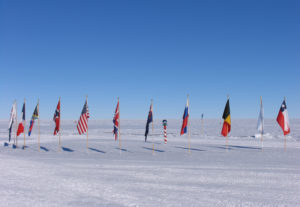Desert at the Bottom of the World
Amundsen-Scott South Pole Station and the South Pole
The southernmost point on the globe features a moving center, altitude sickness, and the largest desert on the planet.
A desert is a region receiving less than 250 millimeters (ten inches) of precipitation per year and can be either a hot or cold desert. The largest desert in the world is the Antarctic Desert, covering 5.5 million square miles of the continent. Upon this icy desert sits the Amundsen-Scott South Pole Station.
The first station at the South Pole was completed in February of 1957. It was rebuilt in 1975. An upgrade was initiated in 1997 and the new station dedicated in 2008. It is well equipped for research, housing the Atmospheric Research Observatory, the Martin A. Pomerantz Observatory, the IceCube Observatory used to observe neutrinos, the Dark Sector Laboratory housing the South Pole Telescope and the Keck Array, and computer systems for research.
The Amundsen-Scott South Pole Station was named in honor of two explorers: the Norwegian Roald Amundsen and Royal Navy officer Robert Falcon Scott, who reached the South Pole in 1911 and 1912.
The station sits at an elevation of 2,835 meters (9,306 feet) on Antarctica’s ice sheet, 850 nautical miles south of McMurdo Station. The ice sheet—two miles of vertical ice—drifts about 10 meters (33 feet) each year. A striped pole topped with a reflective globe marks the ceremonial South Pole. The actual geographical South Pole shifts with the ice.
Visitors to the South Pole are prone to develop altitude sickness from the relatively quick ascent from McMurdo Station and the dry air. Some are affected immediately and must take the snowmobile ride from the plane to the station. Others are affected later. It catches up to everyone there eventually.
Without a Sound: Creation’s Silent Worship
The heavens tell of the glory of God;
And their expanse declares the work of His hands.
Day to day pours forth speech,
And night to night reveals knowledge.
There is no speech, nor are there words;
Their voice is not heard.– Psalm 19:2-3 NASB
Polar lights (aurora polaris) are found in both the northern and southern hemispheres. Most people have seen, or at least heard of, the Northern lights (aurora borealis). The southern polar skies are the canvas for a grand – if lesser known – display.
Timestorm Films has produced a breathtakingly beautiful video of the aurora australis, or southern lights, at the South Pole. They are seen here with the Milky Way, a phenomenon only experienced in Antarctica.
South Pole Photo 12519138 © Darryn Schneider | Dreamstime.com






















Leave a Reply